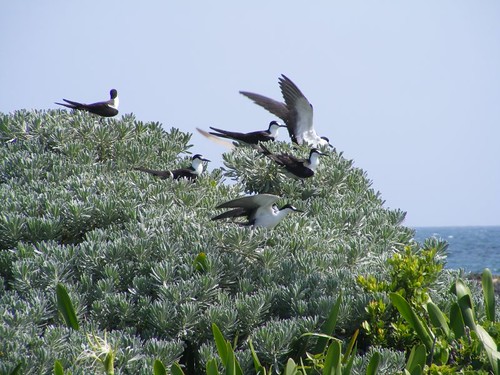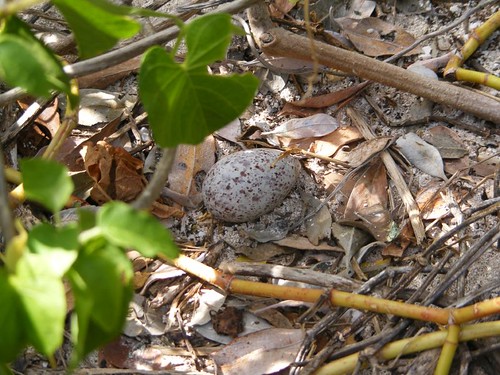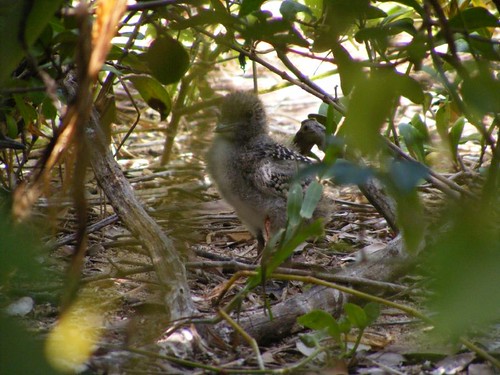July 16 – 20, 2010
This is where we have ended up the last two years because it is as far west as we can be before we have to make the commitment to head back to Florida, and it is a good location for us to access the offshore reefs located near enough for us to get to with the dinghy. Most cruisers who come here only do so so that they can go fishing or diving. The anchorage has fair holding if winds are in the range of E to SW. Outside of those directions, it is too open to be as safe and comfortable as we would like.
If the winds are too high to get offshore, we can do a little spearfishing, at slack tide only, around Burying Piece Rocks (don't ask me how anyone came up with the names of the places we stop or how they end up spelling them, which often times, is more than one way for the same place!). BP Rocks border the anchorage, so are easy for us to get to and from without using a lot of gas or spending time traveling.
We had some fun catching some hog fish and grouper and just looking at some of the other life that congregated to the rocky area. One time I looked over and saw a small nurse shark rising up from the bottom and heading right toward Eddie. I knew he didn't see it and it wasn't acting aggressively, so I decided to see what was going to happen without getting Eddie's attention. The shark went right up to him and gave him a sniff and then spun around and took off, like Eddie's odor wasn't to its liking! Some time later, a remora came off a big nurse shark and decided we looked like a better “ride”, so it kept coming up to both of us, trying to hook on. Remora have approached us before, and if I stick out my flipper, they seem happy to rest on it before taking off and going back to where they belong.
My best underwater adventure at this anchorage was when we were snorkeling in one of the cuts and two, 60 lb. tarpon were swimming nearby and stayed in the area for quite a while. I have never seen tarpon in the Bahamas before, so it was a neat, unexpected surprise. Tarpon are such a majestic looking fish, having huge heads, large eyes, and upturned mouths. Their bright, shiny silver scales are the size of silver dollars. The sunlight sparkles off the scales, almost making them look like stainless steel torpedoes underwater. I had a hard time falling asleep that night thinking about swimming with those “silver kings”.
Wells Bay has a very nice beach for walking or wallowing in the water. One morning, we took Ursa ashore to burn off some of her energy and walked to the far end. I noticed a path leading into the underbrush and decided to see where it led. I walked about ¾ mile and came to an open area where a group of people (adults and children) were working on clearing more of the underbrush. They were a group of locals who were clearing land for a ministry they were trying to establish. The land is accessible only by boat, so they had to be dropped off with all the tools, food, etc. they needed for their work day. They had done all the clearing work using chain saws, machetes, shovels, and wheelbarrows-this was a laborious chore to say the least. They had cleared the path I had walked on, an area for a building foundation to be erected, an area for a garden they had planted, and an area to offload all their supplies from the inland tidal creek they used to get to the site from the mainland. I was impressed with their efforts. I had arrived in time to watch one of the men feeding some large snappers stinky conch scraps on the incoming tide. I remarked that the group didn't have to worry about going hungry with all those fish around.
My stay in Wells Bay isn't complete unless I go out to Conchshell Cay and collect sea glass. This year I had an additional surprise, seeing that the western end of the cay had been taken over by a breeding colony of sooty terns, numbering over a thousand. In the U.S., breeding sooty terns are only found in the Dry Tortugas. When not nesting, they spend their time feeding in the open ocean unless they are blown toward the coast by storms. So, I welcomed the chance to get some pictures of the nesting activity. The opening photo shows several adults sitting on bay lavender.
Wayne dropped Eddie and I off at the cay because it is difficult to find a place to anchor the dinghy. The sea bottom is hard and rocky and there is no landing beach, so you have to anchor off and wade in, carefully finding your footing on the rocks. Wearing water shoes is mandatory because the rocks are full of urchins!
I told Eddie to minimize his movements so that we wouldn't disturb the colony any more than was necessary to get the photos. We had to walk a ways into the prickly brush, watching carefully where we put our feet so that we wouldn't step on any eggs. Eddie remarked that it looked like we weren't the first people to walk in, as it seemed the underbrush was beaten down in several spots.
The females lay one, brownish-red speckled egg, kind of in a small depression in the underbrush, which surprised me. The other sea birds we have seen have nested out in the open. In fact, it was difficult for the adults to move through the underbrush to be able to take flight.
When I squatted down and peered through the lower, more open level of the brush, I could see chicks of varying ages and the adult birds trying to stay close to them. The chicks were very afraid and kept moving farther away, so it was difficult to be able to get close for a real good photo.
When we completed the photographic session, we began looking for sea glass. I could hear the whirring of an approaching outboard motor. A small skiff containing three locals landed offshore around the point from where we were and waded in carrying white sacks. Our friends had told us that they had seen the natives collecting sea bird eggs in the past, so I figured, with dread, that's what they were going to do too.
I was pretty disturbed to think about being around for that activity, and the adult birds were going crazy, screeching and flying in all directions. Just up from where I was looking for glass, one of the men came barreling through the bushes, and to my distress, bent down and came back up with a chick squeezed in his hand and threw it in the sack. I thought about the irony of how careful Eddie and I had been and then to see these guys acting like elephants in a home vegetable garden. I have to keep telling myself that many of the locals have limited resources and have to live off the land as much as possible and, hopefully, they don't deplete the bird populations enough to affect the total population.
To get our minds off the idea of having to eat sooty tern eggs and chicks, Chef Wayne cooked up a delicious bistro-style meal of stromboli and pizza. Accompanied with some ice cold brewskis, we were in culinary heaven.
Friday, August 13, 2010
Subscribe to:
Post Comments (Atom)












Wow! Nice Pizza Wayne!
ReplyDeleteAlmost looks as good as a deep dish UNOs Spinocalli!!!
Great Photos! Bob and I are having some work done on Veda L this fall and will be heading down the T.T. by Nov 1 to parts unknown as yet! I sure am enjoying my two little grandgirls (munchkins)this summer though! Good fishin and safe travels!
ReplyDelete